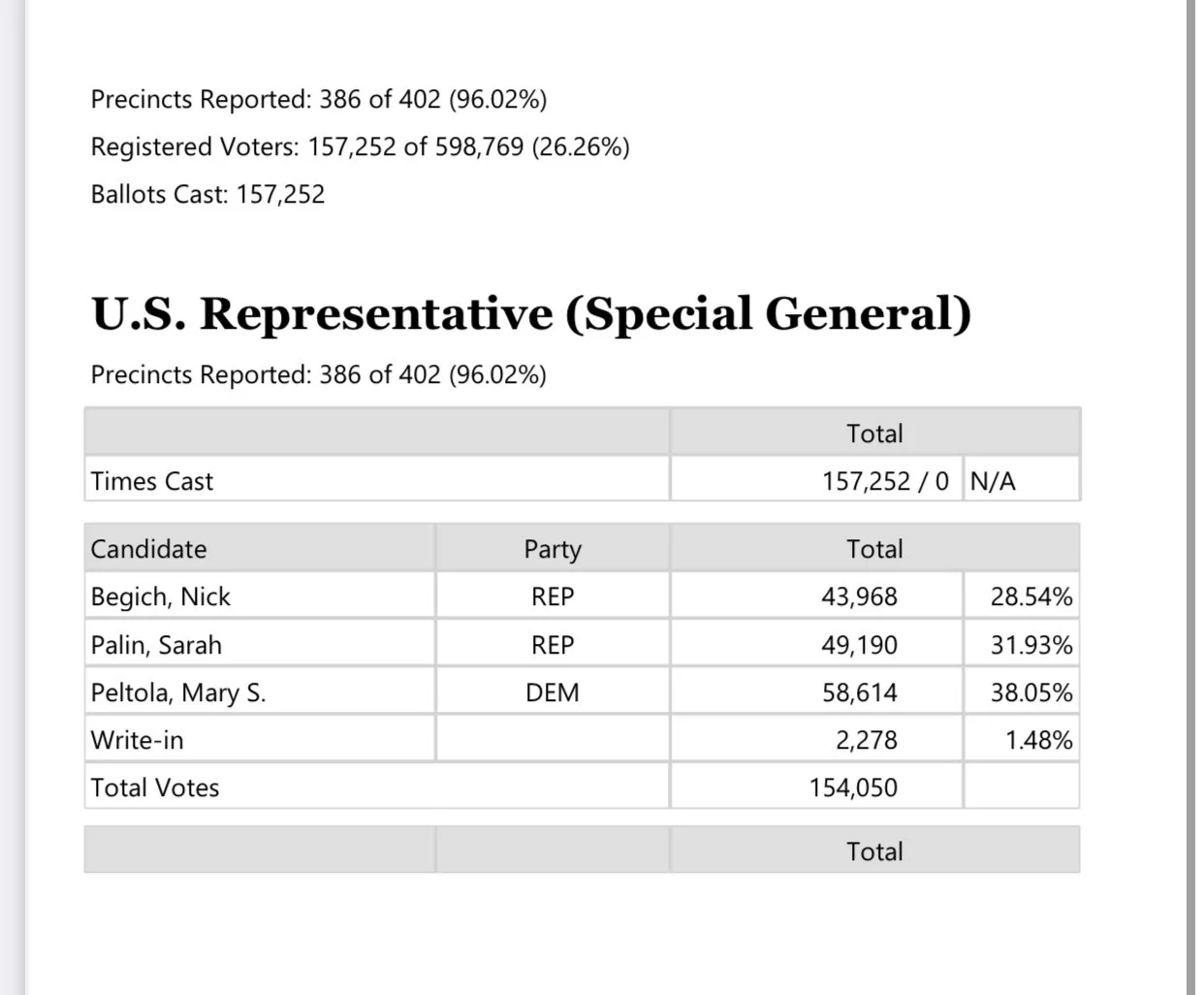Peltola, Palin lead race for temporary seat in Congress, topping Begich
Whoever wins the special election to serve the final days of Don Young’s final term will claim to have a big advantage going into the general election in November.
But at least three credible contenders will make sure to say over and over that the Rep. Temp is not the Congressman or Congresswoman for All Alaska.
There are three main reasons why the temporary winner will not have a big advantage: First, the term will be over in a flash. Second, there is no consensus candidate set up to win a landslide. Third, the winner may not get the most first-place votes, a result that every opponent will describe as a hollow victory.
The winner will enjoy a fundraising advantage, hitting up all potential donors as the “incumbent.” That will be an edge, especially Outside, where most of the money is. But donors who look closely will see that the incumbent doesn’t have a Don Young hand-crushing grip on the seat.
It will be telling to see how Mary Peltola or Sarah Palin will wear the temporary crown as the most junior member of the U.S. Congress.
There will be little actual representing and lots of electioneering in the months ahead, as the U.S. House will not be in session for most of the time between September and Jan. 3.
The Young replacement will barely have enough time to stock up on Alaska flag pins and business cards.
If Palin or Peltola start to issue official announcements and campaign material making liberal use of “Representative,” it will be a clear example of federal overreach.
Only four people have ever represented Alaska in the U.S. House with a vote—Ralph Rivers, Howard Pollock, Nick Begich I and Don Young. We are in this predicament because Young refused to retire and he held immense power as an incumbent, beating every challenger except the one that eventually gets all of us.
As the votes released Tuesday night showed, it is unlikely that a candidate will emerge from the special general election with 50 percent of the vote plus one. That means that the winner will be determined by ranked choice voting. And we won’t know those results for a couple of weeks.
I know almost everyone will be confused by the next few paragraphs, but speculation is all we have to work with.
Nick Begich the third looks like a good bet to finish third, leaving him out of the temp contest, but still in the running for November. Palin the first is likely to complain about running second to Peltola.
The second-choice votes will likely decide the race.
If most Begich voters listed Palin as a second choice—which is not at all a sure thing—-Palin may be the winner. Peltola can only hope that enough of those who think of Palin as The Quitter went with Peltola as a backup. There are many Alaskans who will refuse to vote for Palin. Perhaps more than the sizable contingent that would never vote for a Democrat.
In any case, Peltola will run for the full term as the candidate who picked up the most first-place votes. She will make heavy use of that result and try to position herself as a front runner. Peltola has reason to be optimistic with results that solidify her as a statewide candidate to be taken seriously.
Begich III didn’t do well at all. The party machinery backing him failed to translate into votes. Palin didn’t campaign as much as use her celebrity status.
If Palin wins, she will be reminded by her opponents—especially Begich— that the temporary title is not all that glorious when the winner is someone who failed to get the most first-choice votes.
Speaking of multiple choices, there was a separate primary election for the U.S. House, with different numbers but the same results. This is the election on the front of the ballot that features 22 candidates—the top four candidates will be on the November ballot.
The top four are Peltola, Palin, Begich and Sweeney. Sweeney ran a distant fourth, but will be a solid contender.
I promise this will make more sense in the weeks ahead. I hope I’m right.
Finally, everyone should start paying close attention to the U.S. House rules prohibiting the use of official resources for campaigning.
Alaskans will be getting unsolicited mass mailings as soon as we know if it is Palin or Peltola who replaces Young for four months. But House rules require that government funds cannot be used for these mailings within 90 days of an election. The mass mailings have to be paid for with campaign funds.
There are loopholes in the federal rules, however, and a lot is left to interpretation.
There is no doubt that the entire focus of the Temporary’s time in office will be on winning the general election in November. The holder of the office will deny this, of course.
Your contributions help support independent analysis and political commentary by Alaska reporter and author Dermot Cole. Thank you for reading and for your support. Either click here to use PayPal or send checks to: Dermot Cole, Box 10673, Fairbanks, AK 99710-0673

